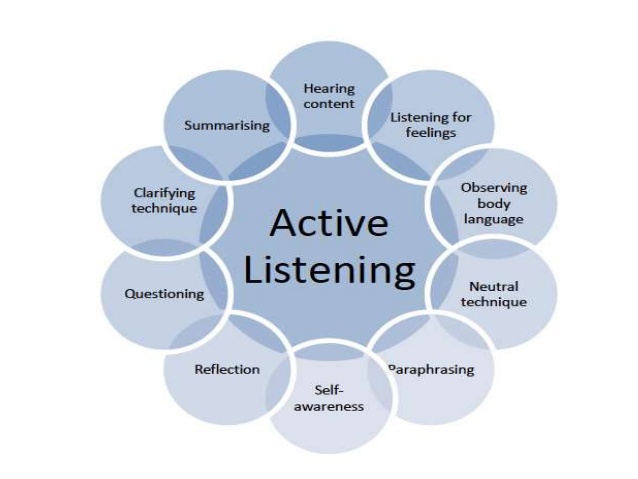 There are six active listening skills set. Firstly, paying attention can be indicated through body language, such as keep the eye contact (but not too intense) during the interview as a sign that we are engaged in the conversation, crossed arms and crossed legs are might an indicator of less involvement, slight lean forward indicates that we are interested in the conversation. Secondly, withhold judgement can be applied through maintain calm and neutral facial expression, also put away our personal thoughts, values, and beliefs while we listen to the speakers. Thirdly, reflecting can be applied by telling a short story about our own similar experience according to the related topic. Fourthly, clarifying is a technique to ensure that you get and understand the information correctly, usually used when clients’ story gets confusing. Fifthly, summarizing/ paraphrasing is remembering all of the information that you have heard and repeating those information back to the clients with your own words. But, do not repeat using the exact same words because it can make an assumption that you are just hearing not listening (understand). Lastly, sharing a story about the relevant topic. However, do not over disclose, because it can change the dynamic of the interaction which leads to awkward or uncomfortable situation. Moreover, a lot of clients having difficulties or a bit reluctant to ‘truly’ disclose their problems and ideas during the interview with health care practice, and they often imply their ideas through ‘clues’. Applying Active listening can help health service management team to identify the ‘clues’ by focusing on clients’ expression of feelings, try to understand and re-explain their problems , tell personal stories that are linked to the clients condition or risks (Lang et al., 2000). In addition, active listening can provide comfort to the clients, increase their understanding, trust, and clinician-patient agreement (following the suggestion given by the health care professionals) and increase their trust and more access to healthcare (Street et al., 2009). Also, it can benefit individual mental growth and helps clients to have a better management of their emotions (Rogers & Farson, 1979).
There are six active listening skills set. Firstly, paying attention can be indicated through body language, such as keep the eye contact (but not too intense) during the interview as a sign that we are engaged in the conversation, crossed arms and crossed legs are might an indicator of less involvement, slight lean forward indicates that we are interested in the conversation. Secondly, withhold judgement can be applied through maintain calm and neutral facial expression, also put away our personal thoughts, values, and beliefs while we listen to the speakers. Thirdly, reflecting can be applied by telling a short story about our own similar experience according to the related topic. Fourthly, clarifying is a technique to ensure that you get and understand the information correctly, usually used when clients’ story gets confusing. Fifthly, summarizing/ paraphrasing is remembering all of the information that you have heard and repeating those information back to the clients with your own words. But, do not repeat using the exact same words because it can make an assumption that you are just hearing not listening (understand). Lastly, sharing a story about the relevant topic. However, do not over disclose, because it can change the dynamic of the interaction which leads to awkward or uncomfortable situation. Moreover, a lot of clients having difficulties or a bit reluctant to ‘truly’ disclose their problems and ideas during the interview with health care practice, and they often imply their ideas through ‘clues’. Applying Active listening can help health service management team to identify the ‘clues’ by focusing on clients’ expression of feelings, try to understand and re-explain their problems , tell personal stories that are linked to the clients condition or risks (Lang et al., 2000). In addition, active listening can provide comfort to the clients, increase their understanding, trust, and clinician-patient agreement (following the suggestion given by the health care professionals) and increase their trust and more access to healthcare (Street et al., 2009). Also, it can benefit individual mental growth and helps clients to have a better management of their emotions (Rogers & Farson, 1979).
This video below will explain about the steps of demonstrating active listening.
References
Lang, F., Floyd, M. R., & Beine, K. L. (2000). Clues to patients’ explanations and concerns about their illnesses: A call for active listening. Archives of Family Medicine, 9(3), 222-227. Retrieved from https://triggered.clockss.org/ServeContent?url=http://archfami.ama-assn.org%2Fcgi%2Fcontent%2Ffull%2F9%2F3%2F222
Rogers, C., & Farson, R. E. (1979). Active listening. Organizational psychology, 168-180. Retrieved from http://files.teachingjedi.webnode.com/200000004-6f61f705bf/ActiveListening_RogersFarson.pdf
Street, R. L., Makoul, G., Arora, N. K., & Epstein, R. M. (2009). How does communication heal? Pathways linking clinician–patient communication to health outcomes. Patient education and counseling, 74(3), 295-301. Retrieved from http://www.sciencedirect.com/science/article/pii/S0738399108006319
SpunOut.ie. (2015, October 4). 6 tips for active listening #Littlethings. Retrieved from https://www.youtube.com/watch?v=oWe_ogA5YCU